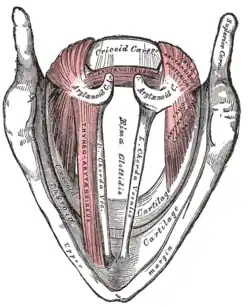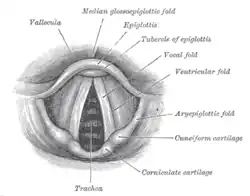Rima glottidis
| Rima glottidis | |
|---|---|
 Muscles of the larynx, seen from above | |
 The entrance to the larynx. | |
| Details | |
| Identifiers | |
| Latin | Rima glottidis |
| TA98 | A06.2.09.014 |
| TA2 | 3208 |
| FMA | 55472 |
| Anatomical terminology | |
The rima glottidis is the opening between the true vocal cords and the arytenoid cartilages of the larynx.
It is normally subdivided into two parts: that between the arytenoid cartilages is called the intercartilaginous part (or the intercartilaginous glottis, respiratory glottis, or interarytenoid space), and that between the vocal folds the intermembranous part (3/5th) or glottis vocalis.
It is closed by the lateral cricoarytenoid muscles and the arytenoid muscle.
It is opened by the posterior cricoarytenoid muscles.
Anteriorly it is attached to the middle angle of thyroid cartilage. Posteriorly it is attached to vocal process of arytenoid cartilage
It is limited posteriorly by interarytenoid fold of mucous membrane. The shape of Rima glottidis is changed by movements of vocal cords.
It is the narrowest part of larynx. It is longer (23mm) in males than in females (17mm).
All of these muscles receive their innervation from the recurrent laryngeal nerve which is a branch of the vagus nerve (CN X). This nerve can be vulnerable in thyroid surgery. Any damage to the rima glottidis may result in a hoarse voice, aphonia or difficulty breathing.
References
![]() This article incorporates text in the public domain from page 1080 of the 20th edition of Gray's Anatomy (1918)
This article incorporates text in the public domain from page 1080 of the 20th edition of Gray's Anatomy (1918)
External links
- Anatomy photo:32:st-1300 at the SUNY Downstate Medical Center